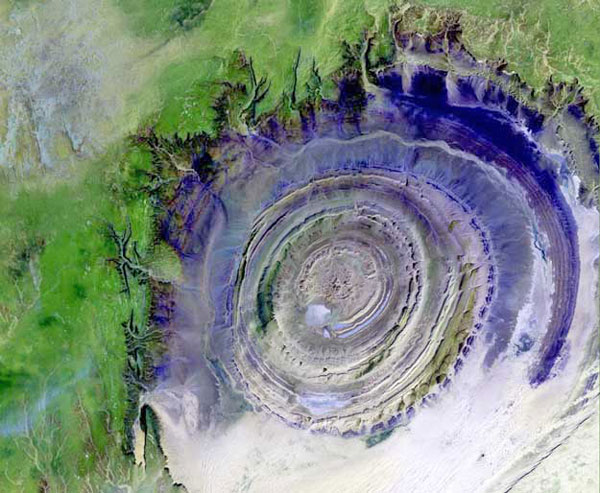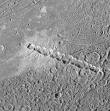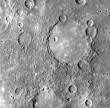|

by David Talbott
from
Thunderbolts Website
Apr 07, 2005

What was the cause of this uplifted region on the Saharan desert
floor cut by a circular crater with concentric terraces? Geologists
speculate that erosion by wind and water must have worked its magic
on the upraised dome. Electric theorists see something elseóthe scar
left by electric discharge.
In the October 28, 2002 Astronomy Picture of the Day the
"explanation" goes like this:
"What on Earth is that? The
Richat
Structure in the Sahara Desert of Mauritania is easily visible from
space because it is nearly 50 kilometers across. Once thought to be
an impact crater, the Richat Structureís flat middle and lack of
shock-altered rock indicates otherwise. The possibility that the Richat Structure was formed by a
volcanic eruption also seems
improbable because of the lack of a dome of igneous or volcanic
rock. Rather, the layered sedimentary rock of the Richat Structure
is now thought by many to have been caused by uplifted rock sculpted
by erosion.... Why the Richat Structure is nearly circular remains a
mystery."
Electric Universe proponents consider the circularity of the Richat
Structure to be predictable. So they pose a different question for
planetary scientists: What on Earth and Moon,
Mercury
(click on below images), Venus,
Mars,
Io,
Europa, Phobos,
Mimas and Tethys,
Enceladus,
Miranda,
Eros, and
other asteroids, etc. are these? Geologists have never adequately
explained why almost all craters everywhere are circular. This has
only been dismissed as a feature of impacts, something that has
never been demonstrated, but only surmised. Other features of
various circular craters -- domes, spheres, steep walls,
chains,
central peaks with strata consistent with the walls or surrounding
terrain, undisturbed strata in the floor, unexpected size
distribution, unexpected placement distribution (such as location on
the
rim of other craters),
elevated ramparts
-- all defy coherent
explanation under the impact model.
|

Mercury |

Mars |

Io |

Europa
|

Mimas and Tethys
|

Enceladus |
|

Miranda
.
|

Eros
|

other asteroids
.
|

domes
.
. |

chains |

rim of other craters |

elevated ramparts
Advocates of the EU model claim that craters like the Richat were
not formed by impacts but were "machined" by electric discharges,
Birkeland currents that rotate around a "sticking" point and
excavate material by electrically accelerating it upwards without
disturbing the surrounding or underlying strata, unless the whole
area is raised in a fulgamite blister--hence Rampart Craters.
Specific effects will depend on a wide variety of soil conditions
including chemical composition, material type, density, moisture,
and conductivity. Discharge factors, including diameter, voltage,
current, and duration will also affect the crater configuration.
In contrast to conventional theorists, advocates of the electric
universe contend that planets moved under the influence of
electrified plasma, a medium that can easily overwhelm gravity.
Orbits changed, and catastrophic electrical encounters altered the
terrain, the climates, and the atmospheres of planets, including our
Earth.
In the case of the Richat Structure, it is evident that the force
uplifting the area also cut the concentric crater walls. In crater
formation, the electrical forces constrain the arc to contact the
surface at a 90-degree angle. Because the arc typically consists of
one or more pairs of channels rotating around a common axis, a
stationary arc will etch a circular crater and, in stratified
terrain, will machine out concentric circles.
|














